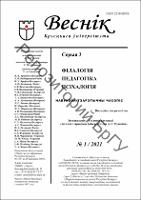Показать сокращенную информацию
Развитие представлений о множестве у детей старшего дошкольного возраста
| dc.contributor.author | Будько, Татьяна Степановна | |
| dc.date.accessioned | 2022-01-31T08:06:05Z | |
| dc.date.available | 2022-01-31T08:06:05Z | |
| dc.date.issued | 2021 | |
| dc.identifier.citation | Будько, Т. С. Развитие представлений о множестве у детей старшего дошкольного возраста / Татьяна Степановна Будько // Веснiк Брэсцкага унiверсiтэта. Серыя 3, Фiлалогiя, педагогiка, псiхалогiя. - 2021. - N 1. - С. 91-98. | ru_RU |
| dc.identifier.uri | https://rep.brsu.by:443/handle/123456789/7544 | |
| dc.description | This article describes the stages and methods of the development of ideas in older preschool children about a set, an element of a set, a part of a set; familiarizing them with a graphical representation of a set and relationships between elements of sets; the formation and development of children's skills to find elements of intersection, joining, and subtraction of two sets. For all stages, various methods are indicated that contribute to familiarization with these concepts, the introduction of the corresponding terms into the active vocabulary of older preschool children. Among them – both questions in a conversation about the objects around children, and special questions that allow children to actively reflect on the essence of the discussed concepts. To consolidate this material, examples of various types of games (didactic, plot-role, logical-mathematical), game exercises, educational situations in different types of activities are given. | ru_RU |
| dc.description.abstract | Описаны этапы и методы развития представлений у детей старшего дошкольного возраста о множестве, элементах множества, части множества; ознакомления их с графическим изображением множества и отношений между элементами множеств; формирования и развития у детей умений на-ходить элементы пересечения, объединения, разности двух множеств. Для всех этапов указаны различные методы, способствующие ознакомлению с данными понятиями, введению соответствующих терминов в активный словарь детей старшего дошкольного возраста. Среди них как вопросы в беседе об окружающих детей предметах, так и специальные вопросы, позволяющие детям активно размышлять о сути обсуждаемых понятий. Для закрепления данного материала приведены примеры различных видов игр (дидактических, сюжетно-ролевых, логико-математических), игровых упражнений, образовательных ситуаций в разных видах деятельности. | ru_RU |
| dc.language.iso | ru | ru_RU |
| dc.publisher | БрГУ им. А.С. Пушкина | ru_RU |
| dc.relation.ispartofseries | Серыя 3. Філалогія. Педагогіка. Псіхалогія; | |
| dc.subject | развитие | ru_RU |
| dc.subject | представления | ru_RU |
| dc.subject | множество | ru_RU |
| dc.subject | дети старшего дошкольного возраста | ru_RU |
| dc.subject | development | ru_RU |
| dc.subject | senior preschool children | ru_RU |
| dc.subject | ideas | ru_RU |
| dc.subject | a set | ru_RU |
| dc.title | Развитие представлений о множестве у детей старшего дошкольного возраста | ru_RU |
| dc.title.alternative | Developing Concepts about the Set in Older Preschool Children | ru_RU |
| dc.type | Article | ru_RU |
